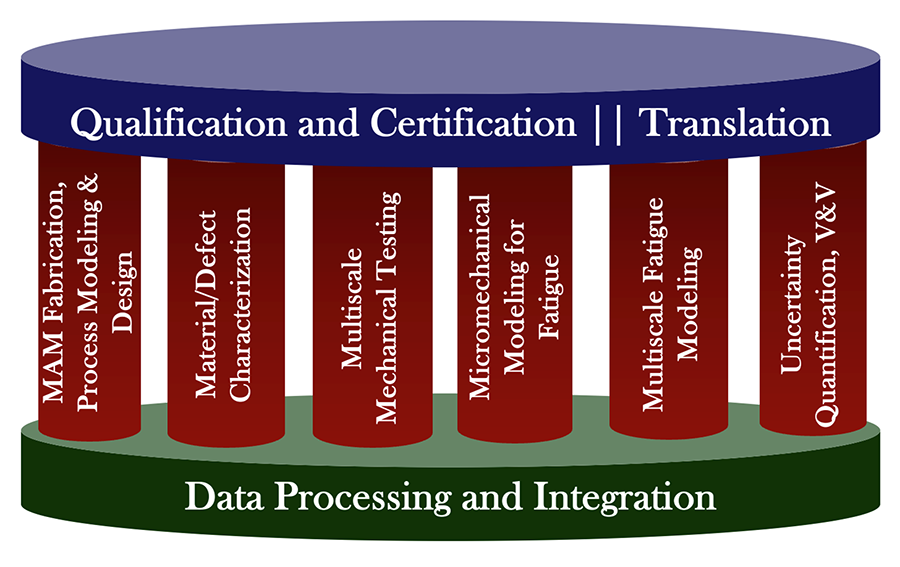NASA Space Technology Research Institute (STRI)
The central goal of our IMQCAM is to innovate a model-centric workflow that closes the critical gaps between current capabilities and what is necessary for efficient qualification and certification (Q&C) of parts by metals additive manufacturing (MAM), meeting NASA standards. To accomplish this, it will build and implement a visionary Digital Twin (DT) of the MAM physical asset as a certifiable surrogate for a model-based Q&C process.

The digital twin is expected to bring a paradigm change in the current MAM Q&C practices undertaken by NASA researchers and practitioners. The platform will comprise an integrated set of varied, experimentally-validated, uncertainty-quantified (V&V/UQ) computational models and simulation and design tools that will mirror the entire materials-processes-structure-property performance and life (MPSPPL) linkage in MAM. It will promote a holistic, cradle-to-grave model-based approach for unraveling the complex subtleties in MPSPPL linkages leading to improved material and process design to meet the Q&C challenge. Such a comprehensive software-enabled workflow has the potential to offer a much broader range of probes than can be afforded by experiment focused approaches. The requirement to link together and integrate multiple component models into the workflow, along with V&V/UQ and data management necessitates a tightknit team working within an institute.
The team brings diversity in terms of the researchers, participation by a minority-serving institution, and institute-wide programs for involving budding scientists from under-represented groups. Innovation and integration will be a cornerstone of the STRI, with world-class researchers who are leaders in their respective fields. For achieving the challenging Q&C goals, the DT platform will be supported by six pillars representing foundational modules of research and implementation.

Pillar 1: AM fabrication, process modeling & design
In addition to the conventional focus on dimensional accuracy, surface roughness, and residual stress, this research will design and fabricate parts exploring extremes in the microstructure not just in defect densities but in variations of the thermal history.
Pillar 2: Microstructure and defect characterization
The characterization process will survey large areas to provide inputs to the development of statistically equivalent representative volume elements (SERVEs) for micromechanical modeling as well as the MAM process modeling framework.
Pillar 3: Multiscale mechanical testing
A major extension of testing methods will be undertaken for the mechanisms-based understanding of fatigue crack nucleation, short crack growth, and fatigue life of AM test samples and components.
Pillar 4: Micromechanical modeling for fatigue
Statistically equivalent representative volume elements (SERVEs) will be advanced to MAM processed material microstructures.
Pillar 5: Multiscale fatigue modeling using PUCCM for crack growth
Uncertainty quantified, parametrically-upscaled constitutive, and crack evolution models (UQ-PUCM/PUCCM) will constitute the principal platform for multiscale fatigue modeling.
Pillar 6: Verification, validation & uncertainty quantification (V&V/UQ)
Sophisticated methodologies of sensitivity analysis, verification, validation, and uncertainty quantification (V&V/UQ) of the materials-processes-structure-property performance and life (MPSPPL) linkage will be developed by integrating physics-based and machine learning models, experimental observations, validation analyses, and Q&C activities.
